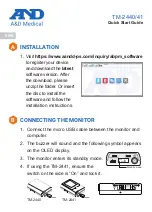
5019T Flat Panel Industrial Touch Monitor Chapter 2 – Installation
16
143627(A)
connector housing should be a metal conductive type (e.g., molded zinc) and
the ground shield braid should be well terminated directly to the connector
housing. Do not use a shield drain wire.
The outer diameter of the cable must be suited to the inner diameter of the
cable connector strain relief in order to ensure that a reliable degree of strain
relief is maintained.
Warning
Never connect or disconnect the communication cables while power is
applied at either end of the cable. This may result in an incendiary
spark. Permanent damage to the workstation communication
components may occur.
Operation and Maintenance
The systems have been designed for compliance with relevant spark ignition
tests. However, please note that the workstation front panel contrast
adjustment tactile switches and keyboard connector are the only make/break
components intended to be exercised by the operator in the course of normal
operation.
Warning
To maintain a safe condition, never use an external keyboard or mouse
or USB port devices when the unit is operating in a hazardous
environment.
Always observe the following rules with respect to hazardous location
installations:
1. Always install the 5019T monitor within an enclosure suitable for the
specific application. General-purpose enclosures may be acceptable for
Class I applications but are never acceptable for Class II applications.
Type 4 (IP 65) enclosures are recommended even when not required by
regulations.
2. If present, keep enclosure doors or openings closed at all times, to avoid
the accumulation of foreign matter inside the workstation.
3. Never subject the unit to any installation or service procedures unless
power is removed and the area is known to be non-hazardous. This
includes the installation or removal of power cables, communication
cables, or removal of the rear cover of the unit.
Only technically qualified service personnel should perform all installation and
service. These workstations are designed to require no service in the course
of normal operation by an operator.
















































